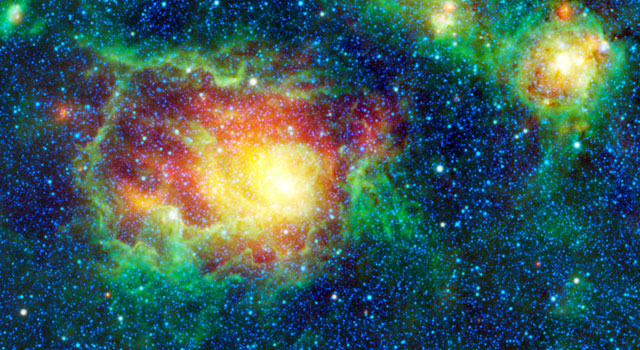http://www.asyura2.com/09/nature4/msg/589.html
| Tweet |
(回答先: In Deep: 太陽系9番目の巨大惑星の存在についての公式アナウンスが近いという報道 投稿者 不動明 日時 2011 年 2 月 15 日 22:49:28)

2012年3月には全データが公開されるので
それをもとにテュケーが存在するかどうか検証される
判明しました。
其の矮星は存在します。
但し、殘念乍らまう間に合ひません。
諦めて下さい。
新たな「第9惑星」発見はいつ? NASAが疑問に答える
http://www.astroarts.co.jp/news/2011/02/21tyche/index-j.shtml
新たな「第9惑星」発見はいつ? NASAが疑問に答える
【2011年2月21日 NASA】
先ごろミッションを完了した天文衛星「WISE」のデータから太陽系の果ての「第9惑星」が見つかるかもしれないと期待されている。もし存在するとすればいつ、どのようにして判明するのか、Q&Aで紹介する。
2010年11月、木星より大きな太陽の伴星が「オールトの雲」(注1)に存在するかもしれないという説が学術雑誌「Icarus」で発表された。「テュケー(Tyche)」と名付けられたこの仮想の惑星が、先ごろ観測終了したNASAの広域赤外線探査衛星「WISE」によるデータから発見されるかもしれないというのだ。
2009年12月に打ち上げられたWISEは、4つの波長による全天サーベイ観測(注2)で、太陽系から遠方の銀河まで約270万枚の天体画像を撮影した。先ごろ完了した延長ミッション「NEOWISE」では、2つの波長による小惑星帯(注3)サーベイなどを行い、低温の褐色矮星(注4)1個、彗星20個、地球近傍天体(NEO:注5)134個と小惑星帯天体約3万3,000個を発見している。
ミッションを終えたWISEは今月17日に冬眠モードに切り替えられ一旦運用を終了しているが、観測データの分析はこれからだ。今年4月から2012年3月にかけて、分析研究用のデータが順次公開される予定となっている。今後どのようにして未知の天体が発見されるのか? 気になる疑問への答えがNASAから発表されている。
Q:テュケーが存在するかどうかはっきりするのはいつ?
WISEのデータにとらえられているかどうかはっきりするまでは2年以上かかる。今年4月にミッション前半のデータが公開されるがそれだけでは不十分だろう。2012年3月には全データが公開されるので、それをもとにテュケーが存在するかどうか検証される。
Q:もしテュケーが存在するならWISEのデータには必ずとらえられているものなの?
必ずとは言い切れないが可能性は高い。WISEは6ヶ月の間をおいて2度の全天サーベイを行っているので、その間にオールトの雲の中で移動している大型天体があれば検出できるはずだ。両方のサーベイで波長12μmと22μmの遠赤外線をとらえているが、これは、テュケーのような木星より大きい低温の褐色矮星からの放射を観測するのに適している。
Q:テュケーが存在するとして、なぜ今まで見つからなかったの?
テュケーのような暗い低温の星は、地球から観測できるほどの可視光を発しない。WISEのような高感度の赤外線望遠鏡なら、その熱放射を赤外線でとらえることができる。
Q:他の惑星はローマ神話から名付けられている(注6)のに、なぜギリシャ神話由来の「テュケー」なの?
1980年代、約2600万年周期の楕円軌道を持つ太陽の伴星の存在が唱えられており、テュケーと同じくギリシア神話の女神である「ネメシス(Nemesis)」の名が与えられていた。仮説では、オールトの雲に近づくたびにその影響で弾き出された小天体が太陽系の中心部までやってきて彗星となり、時には地球に衝突し周期的な大量絶滅(注7)を引き起こすとされていた。しかし近年では大量絶滅の周期性は疑問視されており、それを説明するためのネメシスの必要性もなくなった。
それとは別に、数百万年周期の円軌道で太陽の周囲を周る伴星の存在が仮定されており、地球に厄災をもたらす「ネメシス」と対照をなすものとして、幸運の女神「テュケー」の名がつけられている。
注1:「オールトの雲」 太陽から0.5光年〜1光年程度に広がる球殻状の領域にあると推定される小天体の群落。1950年にオランダの天文学者オールトが提案したもので、長周期彗星(200年以上の周期を持つ彗星)の故郷とされている。
注2:「サーベイ」 特定の天体を観測するのではなく、全天あるいは特定の領域内に存在する天体をひと通り調査する、いわば地図作りのような観測ミッション。
注3:「小惑星帯」 火星軌道と木星軌道の間で小惑星が密集している、リング状の一帯
注4:「褐色矮星」 質量が小さいため核融合反応を起こさない暗い星。
注5:「地球近傍天体」 地球の公転軌道から4,500km以内まで接近する軌道を持つ彗星や小惑星。
注6:「惑星の名前」 水星(英語でMercury)は商業神メルクリウス、金星(Venus)は女神ヴィーナス、火星(Mars)は軍神マルス、木星(Jupiter)はローマ神話でのゼウスの呼び名ユピテル、土星(Saturn)は農耕の神サトゥルヌス、天王星(Uranus)は天空神ウラヌス、海王星(Neptune)は海の神ネプトゥヌスに由来する。
注7:「大量絶滅の周期性」 地球上の歴史において、多数の種類の生物が同時に絶滅する「大量絶滅」がある一定の周期で発生しているのではという説。
〈参照〉
NASA Mission News: NASA's NEOWISE Completes Scan for Asteroids and Comets
〈関連リンク〉
NASA:
「WISE」ミッションページ
「ジェット推進研究所」内ミッションページ
「WISE」ミッションサイト
〈関連ニュース〉
2011/02/07 - WISEが太陽系小天体サーベイを完了 冬眠へ
2010/06/30 - 表面温度が数百度しかない、もっとも低温の褐色矮星の発見
その他「WISE」関連ニュース:
2011/01/26 - WISEが見せた、宇宙空間をつきすすむ星の姿
2010/10/21 - WISEが赤外線で見たスターバースト銀河
2010/10/08 - 「WISE」とハッブル宇宙望遠鏡がとらえたハートレー彗星
2010/09/03 - 地球接近小惑星は予想以上に多様性に富む天体だった
2010/07/23 - 1回目の全天サーベイを終了した「WISE」が見たプレアデス星団
2010/06/07 - 「WISE」、全天の75パーセントのサーベイを完了
2010/02/24 - 「WISE」がとらえた、巨大な星雲や長い尾を引く彗星
2010/01/18 - 赤外線天文衛星「WISE」がファーストライト
2009/12/16 - NASAの赤外線天文衛星「WISE」、打ち上げ成功
Can WISE Find the Hypothetical 'Tyche'? - NASA Jet Propulsion Laboratory
http://www.jpl.nasa.gov/news/news.cfm?release=2011-060
Can WISE Find the Hypothetical 'Tyche'?

This colorful picture is a mosaic of the Lagoon nebula taken by NASA’s Wide-field Infrared Survey Explorer, or WISE. Image credit:
NASA/JPL-Caltech/UCLA
> Full image and caption
February 18, 2011
Background
In November 2010, the scientific journal Icarus published a paper by astrophysicists John Matese and Daniel Whitmire, who proposed the existence of a binary companion to our sun, larger than Jupiter, in the long-hypothesized "Oort cloud" -- a faraway repository of small icy bodies at the edge of our solar system. The researchers use the name "Tyche" for the hypothetical planet. Their paper argues that evidence for the planet would have been recorded by the Wide-field Infrared Survey Explorer (WISE).
WISE is a NASA mission, launched in December 2009, which scanned the entire celestial sky at four infrared wavelengths about 1.5 times. It captured more than 2.7 million images of objects in space, ranging from faraway galaxies to asteroids and comets relatively close to Earth. Recently, WISE completed an extended mission, allowing it to finish a complete scan of the asteroid belt, and two complete scans of the more distant universe, in two infrared bands. So far, the mission's discoveries of previously unknown objects include an ultra-cold star or brown dwarf, 20 comets, 134 near-Earth objects (NEOs), and more than 33,000 asteroids in the main belt between Mars and Jupiter.
Following its successful survey, WISE was put into hibernation in February 2011. Analysis of WISE data continues. A preliminary public release of the first 14 weeks of data is planned for April 2011, and the final release of the full survey is planned for March 2012.
Frequently Asked Questions
Q: When could data from WISE confirm or rule out the existence of the hypothesized planet Tyche?
A: It is too early to know whether WISE data confirms or rules out a large object in the Oort cloud. Analysis over the next couple of years will be needed to determine if WISE has actually detected such a world or not. The first 14 weeks of data, being released in April 2011, are unlikely to be sufficient. The full survey, scheduled for release in March 2012, should provide greater insight. Once the WISE data are fully processed, released and analyzed, the Tyche hypothesis that Matese and Whitmire propose will be tested.
Q: Is it a certainty that WISE would have observed such a planet if it exists?
A: It is likely but not a foregone conclusion that WISE could confirm whether or not Tyche exists. Since WISE surveyed the whole sky once, then covered the entire sky again in two of its infrared bands six months later, WISE would see a change in the apparent position of a large planet body in the Oort cloud over the six-month period. The two bands used in the second sky coverage were designed to identify very small, cold stars (or brown dwarfs) -- which are much like planets larger than Jupiter, as Tyche is hypothesized to be.
Q: If Tyche does exist, why would it have taken so long to find another planet in our solar system?
A: Tyche would be too cold and faint for a visible light telescope to identify. Sensitive infrared telescopes could pick up the glow from such an object, if they looked in the right direction. WISE is a sensitive infrared telescope that looks in all directions.
Q: Why is the hypothesized object dubbed "Tyche," and why choose a Greek name when the names of other planets derive from Roman mythology?
A: In the 1980s, a different companion to the sun was hypothesized. That object, named for the Greek goddess "Nemesis," was proposed to explain periodic mass extinctions on the Earth. Nemesis would have followed a highly elliptical orbit, perturbing comets in the Oort Cloud roughly every 26 million years and sending a shower of comets toward the inner solar system. Some of these comets would have slammed into Earth, causing catastrophic results to life. Recent scientific analysis no longer supports the idea that extinctions on Earth happen at regular, repeating intervals. Thus, the Nemesis hypothesis is no longer needed. However, it is still possible that the sun could have a distant, unseen companion in a more circular orbit with a period of a few million years -- one that would not cause devastating effects to terrestrial life. To distinguish this object from the malevolent "Nemesis," astronomers chose the name of Nemesis's benevolent sister in Greek mythology, "Tyche."
JPL manages and operates the Wide-field Infrared Survey Explorer for NASA's Science Mission Directorate, Washington. The principal investigator, Edward Wright, is at UCLA. The mission was competitively selected under NASA's Explorers Program managed by the Goddard Space Flight Center, Greenbelt, Md. The science instrument was built by the Space Dynamics Laboratory, Logan, Utah, and the spacecraft was built by Ball Aerospace & Technologies Corp., Boulder, Colo. Science operations and data processing take place at the Infrared Processing and Analysis Center at the California Institute of Technology in Pasadena. Caltech manages JPL for NASA. More information is online at http://www.nasa.gov/wise, http://wise.astro.ucla.edu and http://www.jpl.nasa.gov/wise .
Whitney Clavin 818-354-4673
Jet Propulsion Laboratory, Pasadena, Calif.
whitney.clavin@jpl.nasa.gov
2011-060
ロシアは確かに何かのために準備しようと急いでいるように思われます。
RT(ニュース) は、5,000か所の新しい核爆弾避難所が2012年の終わりまでにモスクワで建設されると報告しています。
ロシア当局は、現在の核爆弾避難所が人口のおよそ半分しかなく、非常に旧式なので、これらの新しい避難所が緊急に必要とされると信じます。
当局者は、事実上モスクワの全人口が何分かで爆弾避難所に着くことを可能にするよう望みます。
しかし、「冷戦」が終わっているはずのこの時代に、なぜ5000か所もの核爆弾避難所がこのように緊急に必要ですか?
しかし、爆弾避難所を建てることで忙しかったのはロシアだけではありません。
数年前、上海の民間防衛オフィスは、確実に大規模な地下の避難所の完成を発表しました。
シェルターは、90,000平方メートル以上のエリアをカバーし、一度に最高200,000人の人々を受け入れることができると報告されました。
しかし、その巨大な避難所は、さらに存在した「地下の万里の長城」を1960年代と1970年代に作ったほど大きくありません。
「地下の万里の長城」は、19マイルのトンネルを含み避難出来る、最高300,000人の人々を拘束することができたと推定されます。
伝えられるところによれば、それは軍用品倉庫、病院、劇場と図書館さえ持っています。
それでアメリカ政府はどうですか?
彼らは我々のために爆弾避難所を建てていますか?
2012年末までにモスクワで5000か所の核避難所を - メモ・独り言・戯言 - Yahoo!ブログ
http://blogs.yahoo.co.jp/jennifer1215b/32183220.html
其れが起きるのかはたまた起こすのか或ゐは其の兩方なのか
http://www.asyura2.com/10/warb7/msg/208.html
投稿者 不動明 日時 2011 年 1 月 19 日 21:54:53: yX4.ILg8Nhnko
|
|
|
|
この記事を読んだ人はこんな記事も読んでいます(表示まで20秒程度時間がかかります。)
▲このページのTOPへ ★阿修羅♪ > 環境・エネルギー・天文板4掲示板
|
|
 スパムメールの中から見つけ出すためにメールのタイトルには必ず「阿修羅さんへ」と記述してください。
スパムメールの中から見つけ出すためにメールのタイトルには必ず「阿修羅さんへ」と記述してください。すべてのページの引用、転載、リンクを許可します。確認メールは不要です。引用元リンクを表示してください。